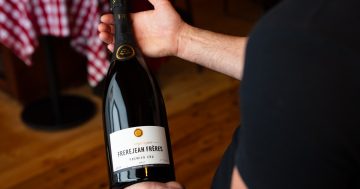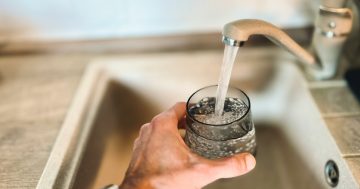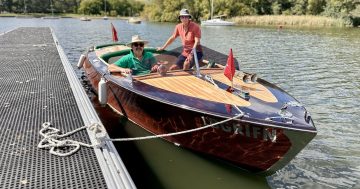Small changes, like catching excess water with a bucket, can help you save big. Photo: Supplied.
Caring for water is caring for Canberra.
Icon Water meter expert Guy Price says the catch phrase rings true, especially with current dry and hot weather conditions.
‘Small changes make a big difference,’ says Guy. ‘Cutting back on your water not only saves water, it saves energy, money and the environment.’
Icon Water is urging Canberrans to take the January Water Challenge.
‘There are heaps of water saving tips on our website,’ says Guy, ‘but one of the most important things you can do for water conservation is to learn how to read your water meter.’
Water meters are usually housed in a plastic box located at the front of a house within one meter of the boundary. The arrangement can be different for units or townhouses who may share a common meter.
Find your water meter in a plastic box at the front of your house. Photo: Supplied.
Each meter register has two sets of numbers—four white dials on the left and four red on the right. Icon Water uses the four white dials with black numbers on the left of the meter to calculate how much to bill customers in kilolitres. The set of red dials with white numbers on the right of the meter show hundreds, tens and single litres and are for customers to use to determine how much water they are using.
‘Regularly reading these numbers helps you understand your water bill, how much water you’re consuming and if you have leaks causing water wastage,’ says Guy. ‘Armed with this knowledge, you can then think of ways to reduce consumption.’
Learning to read your water meter can help you save water. Photo: Supplied.
So, what’s the January Water Challenge?
Icon Water encourages Canberrans to check their water meter, register and write down the number, or snap a photo with your phone, at the start of the month. Then, give yourself a daily target to beat. During the month, use some of the tips and suggestions from Icon Water, Queanbeyan-Palerang Regional Council or the ACT Government to get water usage down. At the end of the month, check the water meter to determine if the household met their target.
One tactic for reducing water use throughout the January Challenge is to monitor usage before and after activities that use larger amounts of water, such as irrigation, taking showers or doing the laundry. With a better understanding of how much water any given activity consumes, customers can make informed choices about how to reduce usage and the amount on their bills.
Another way you can use your meter to save both water and money is by using the dial to the far right (or half crescent shaped dial on round faced meters) to check for leaks. If the dial is moving, then it means water is being used somewhere on the property. If everything is turned off and the dial is still moving, you might have a leak such as through an irrigation system, a dripping tap or a running toilet.
‘If you’ve checked everything is off and the dial is still moving then it might be time to call a plumber to determine where the leak is,’ says Guy. ‘Canberrans leaving town for January should definitely check these numbers before they head off and on their return, to see if water was used while they were away.’
In addition to conserving water by learning how to read the water meter, all Canberrans can participate in the January Water Challenge by visiting Icon Water’s website, which devotes an entire section to preserving this precious resource.
The website has practical tips for home, garden and businesses, and most are free and easy to apply.
At home, about 40 per cent of water used is in the bathroom. ‘One easy way to conserve water in the shower, for example, is to use a bucket to collect water while waiting for it to get hot,’ says Guy. ‘Then use that water for plants in the garden or for cleaning around the house. You can do the same by putting a small bucket in the kitchen sink.’
Outdoor water use accounts for between 25 per cent and 50 per cent of an average home’s water. ‘Big culprits are hosing down pathways instead of just sweeping them, overwatering or watering during the heat of the day,’ says Guy.
Remember too, there should be one meter clearance around your water meter so it can be safely read and maintained. Ensure anything that can inhibit or block access to the water meter, including trees, shrubs and mulch, are regularly trimmed or removed.
For more water saving tips visit Icon Water.


















